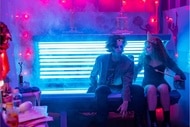Your kids are gonna love it: Designers create custom Back to the Future guitar for charity

You know that new sound you're looking for? Well, listen to this! Doner Designs, a Chicago-based nonprofit that creates custom guitars for philanthropic purposes, made a Back to the Future-themed bass that is totally outta time.
First brought to our attention by Nerdist, the instrument, which sold earlier this month for an undisclosed sum, is a shrunken-down version of Doc Brown's time-traveling DeLorean — complete with destination time display and flashing flux capacitor. *Insert "Great scott!" or "This is heavy" here*
According to Steve Doner (who founded the shop with his electrical engineer son, Richard), the genesis of the guitar can be traced back to 2015, when he helped a friend with some bass repair.
"As he was leaving, he mentioned that he was going to a Back to the Future party on October 21, 2015, which is 'Back to the Future Day,'" Steve recounts to SYFY WIRE. "It's the day Marty McFly and Doc Brown travel to the future in Back to the Future Part II. That conversation sparked the idea to do a Back to the Future-inspired time machine [guitar] as our next charity project. We were done with military themes and were looking forward to something really different. The time machine concept really seemed to have a lot of potential."
Coming up with the idea was easy. Actually building the thing was another animal entirely, a task more daunting than a future ruled by Biff Tannen. Deciding to follow through on their undertaking, the Doners had to answer two big questions: 1) How do we make this look different enough to avoid copyright issues? and 2) How do we shrink an entire car full of sci-fi doodads into a compact guitar shape?
"We started by selecting one of the biggest bass bodies available and with only one pickup, so as to maximize the real estate available for all the electronic gadgetry," Steve says. "After that, Richard designed the circuit boards, which controlled the chasing lights in the 'flux capacitor' and the switching to control the destination year display. We then purchased the necessary electronic parts and started laying out parts on the body we had purchased to make various mockup ideas."
The "flux capacitor" (they use that term informally, so as to avoid tying it directly to the films) was "made of PVC tubing we got at Home Depot," Steve reveals. "Three pieces are joined in the center by a three-way pipe joint 'thingy' and the lights are LEDs that were inserted into the tubing. We cut holes in the tubing using a drill and a box cutter ... Fortunately, the shape and action of the 'fluxy thing' is different enough, while the inspiration is immediately evident to everyone."
To be extra cautious, they also rounded up the 1.21 gigawatt warning to 1.22.
At the time, Richard was still studying to be an electrical engineer at Valparaiso University. Despite his neophyte status, however, the bass never would've been possible without his knowledge of circuit boards, which (as mentioned above) he designed, built, and tested himself.
"If it weren't for that, we couldn't have done it at all," Steve admits. "Richard had to dig pretty deep into what he had learned in his early studies to come up with the circuit board designs and then build and test them. Later, he said that it could have been done more elegantly with his later learnings, but then it wouldn't have had so much of the mad scientist vibe, so it really worked out well."
All the exposed wiring definitely adds an extra layer of authenticity to the piece, perfectly channeling the hazardous-looking interior of Brown's iconic time machine on four wheels.
"We had to mount the batteries on the outside and run a lot of the wiring on the outside to fit everything in," Steve says. "That's not just for looks, though it does work well in terms of the DeLorean vibe. I think you can tell from some of the gut pictures with the main circuit board and all the wires underneath it that in the final moments, we were unsure if we could even pull it off."
After one terrifying circuit board snafu that threatened to derail the entire effort, the construction finally hit 88 mph in the winter of 2018, coming to a close after three years.
"We both have day jobs, so it's a very part-time thing, which made it stretch out," Steve explains. "Actual hours are a guess, but we have estimated it took around 300. In our day jobs, incidentally, I'm an accounting consultant and Richard is an electrical/bio-engineer at Abbott."
Their hard work finally found a good home in early June with buyer Arend Raby, a bass player and collector of unique instruments.
"I'm probably more excited about this instrument than any I've ever acquired," Raby (also an employee at Sweetwater Sound in Fort Wayne, Indiana) said in a statement.
In case you were wondering, the answer is yes — the guitar is fully functional as an instrument (here's a video of it being strummed). We highly encourage that it be used for rockin' covers of "Johnny B. Goode" and "The Power of Love" at the nearest Enchantment Under the Sea dance.
"The instruments can be played but are often purchased more as art," Steve says. "I once heard of a person paying $10,000 just to drink a glass of wine from the Stanley Cup. I'm always hoping for a scenario like that because it's really a donation to a good cause with the guitar being like a perk or souvenir."
Steve and Richard were hoping to get the guitar signed by Michael J. Fox (Marty) and/or Christopher Lloyd (Doc), but unfortunately the stars did not align for either outcome. Nevertheless, all proceeds from the sale were given to Fox's Foundation for Parkinson's Research — donated in the memory of of Robert K. Blackburn, father of Bill Blackburn, runner-up in the bass auction.
Past Doner creations (guitars inspired by government organizations like Army, Air Force, and NASA) have benefited the Make-A-Wish Foundation, the Juvenile Diabetes Research Foundation, the United Services Organization, and the Cystic Fibrosis Foundation.
Up next, the fabulous Doner boys are working on a guitar inspired by Mad Max (what a lovely day!). The biggest problem they need to overcome at the moment is figuring out a safer alternative to a flamethrower.
"Fury Road had a double neck flamethrower guitar/bass combo, of course. Ours will be more of a Road Warrior-type theme," Steve says. "We have a speedometer and tachometer and distributor cap already here, and are pondering how to incorporate those. For the flamethrower, we could use one of those big torches that people use for burning weeds and such. Home Depot and others sell them. That would be fairly easy and awesome. Our concern is liability, so we are trying to figure out what to do about that. One possibility is to use a fake torch bulb in the end of a real torch."
After we reached out, Steve got the idea for a toy chainsaw (sorry, Leatherface) as a nod to Sharknado, which would turn the next bass into a cinematic hybrid.
"Because of SYFY reaching out, I was thinking this morning — actually joking with my wife — about using a toy chainsaw instead of a flamethrower for the Mad Max guitar/bass," he says. "So, it would sort of be a combo movie inspiration if we took that path ... We also talked about a powered Super Soaker-type squirt gun or Nerf gun. Richard thought those would be too cheesy."
Steve was gracious enough to provide SYFY WIRE with a first glimpse at the post-apocalyptic project, which is in the very early stages. Right now, it's still 100 percent George Miller.






































